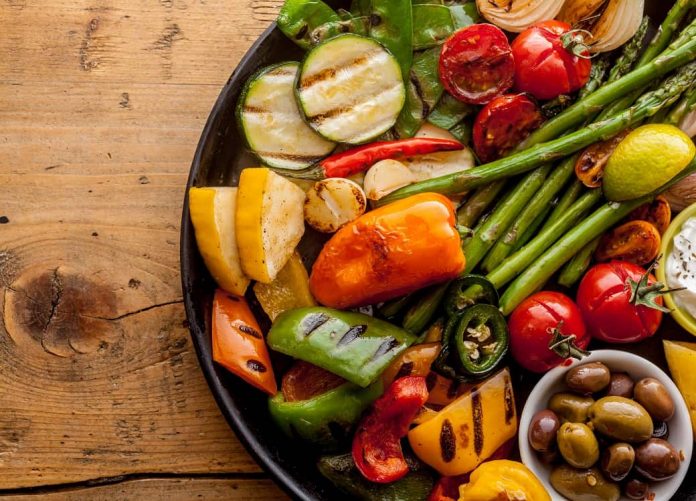It’s not the end of the world if you don’t like vegetables, but they are the pinnacle of health when it comes to your diet — these fiber-filled rockstars are key players when it comes to healthy digestion, weight management, satiety, longevity, and disease prevention.
But good news for veggie haters!
Over time, your taste buds reduce in number and size, thus rendering your taste senses less sharp so things you hated as a kid you might actually enjoy as an adult.
You still might not go from veggie hater to veggie lover overnight, but with a few simple mental shifts and some handy tips in the kitchen, you’ll be on your way to becoming a big fan.
The Benefits of Eating Vegetables
You’ve been told to eat your peas — and other veggies — for as long as you can remember.
But do you know why? Here are three good reasons:
1. Vegetables provide a nutrient bang for your caloric buck
A side-by-side comparison illustrates that for almost the same number of calories, you can either consume 32 baby carrots with two tablespoons hummus or an ounce and a half of pretzels.
Both are crunchy snacks, but carrots and hummus are a more nutrient-rich snack choice.
Not only can you eat a bigger portion, but it also provides fiber, healthy fats, protein, quality carbohydrates, vitamins, minerals, and other phytonutrients.
In her research, Dr. Barbara J. Rolls, Professor of Nutritional Sciences at Penn State University, found that eating vegetables promotes satiety, thus resulting in fewer total calories consumed.
In laymen’s terms: Foods like big, bulky salads or vegetable soup may help you feel more satisfied, even if you’re eating fewer calories.
2. Fruits and vegetables can help you stay “regular”
Talking about fiber might not be sexy, but when it comes to feeling full and losing weight, eating enough fiber can help make that easier.
Fiber is the indigestible portion of plants and takes longer to move through the digestive system, which can promote that “full feeling.”
Fiber also adds bulk to your stool, which helps keep things moving along.
But most Americans only get approximately 16 grams of fiber per day, significantly less than the USDA Dietary Guideline’s recommendation of 25–38 grams.
This is mostly due to an overconsumption of packaged, processed foods void of fiber, and a diet lacking in fiber-rich fruit, vegetables, whole grains, and legumes.
If you’re looking to add more fiber to your diet, for every fruit serving, aim for two veggie servings, until you reach seven to nine total combined servings per day.
3. Vegetables are versatile
Stay with me here: You may have grown up eating soggy boiled green beans or overcooke
Find your “starter” vegetable
There are all kinds of vegetables out there and they all taste different.
If you don’t already have a favorite veggie, take advantage of opportunities to taste-test different ones at a restaurant or at a dinner party — or if you’re feeling brave, get in the kitchen and start experimenting.
When you come across something that you like, this is your “starter” veggie. Common vegetable varieties include:
Leafy greens (spinach, kale, romaine, arugula, dandelion greens, bok choy)
Cruciferous vegetables (broccoli, cauliflower, brussels sprouts)
Allium (garlic, onion, shallots, leeks)
Root vegetables (sweet potato, carrot, parsnip, celery, radish)
Gourds (squash, pumpkin, zucchini)
Nightshades (eggplant, tomato, white potato, okra)
Beans and legumes (black beans, kidney beans, garbanzo beans, soybeans, lentils)
Once you’ve found your starter veggie, you can start experimenting with different preparations until you find the right one for your taste buds.
Experiment with cooking techniques
Whichsounds better, boiled carrots or roasted rainbow carrots with maple glaze? Steamed broccoli or roasted broccoli with peanuts?
When you’re iffy on veggies, roasting them is usually a good place to start because it brings out the natural sweetness of each vegetable through a process called caramelization.
Not a fan of roasting? Consider using the grill. Grilled kabobs may spark fond memories of backyard barbecues.
Associating vegetables with happy times can help reframe your disdain for them.
Add sauces, herbs, spices, and dips
While it may be counterintuitive to add calories just to get you to eat your veggies when done within an overall healthy diet, you can still achieve the weight-loss results you want — and eventually, you may find you don’t need the dips and sauces at all!
Dip raw celery or jicama in hummus, spread some all-natural peanut butter over celery sticks (add raisins for that classic ants on a log treat), or kick up your green beans with fresh garlic.
Or try this recipe for Miso-Glazed Acorn Squash or these Balsamic-Glazed Brussels Sprouts.
Some people have a certain taste receptor gene that can increase sensitivity to bitter flavors found in certain vegetables like brussels sprouts, broccoli, and kale.
But with the right flavorings (lemon or cinnamon) and preparation methods (sautéed with fresh garlic or roasted with coconut oil), an otherwise bitter leafy green or floret can become a must-have sidekick to your main dish.
Mix it up
Try multiple veggies at once instead of singling them out.
Something like this Winter Superfoods Bowl can help you combine various flavors and textures into a mixed dish that may suit your taste buds quite nicely.
Go stealth mode
We all know that cheese and bacon can make anything taste ten times better and sure, you can smother cauliflower in cheese and call it Cheesy Cauliflower Nachos, but why not add veggies to the foods you already love?
Researchers have found that “hiding” veggies in your favorite recipes can help boost your vegetable consumption and decrease total daily caloric intake for the double win.
Some sneaky ideas:
Add puréed veggies to your pasta sauce.
Mash cauliflower into mashed white potatoes.
Blend baby spinach into your fruit smoothie.
Add puréed pumpkin to your pancake batter or prepared oatmeal.
Top your pizza with mushrooms.
Mix half spaghetti noodles with half zucchini noodles.
Add chopped mushrooms or carrots to your hamburger patty, or better yet, be brave and make a black bean veggie burger.
How to Buy Vegetables
Whether you buy fresh, frozen, pre-cut, or canned depends on how you plan to cook your vegetables — and how much time you have to prepare them.
Fresh
“Fresh is best” — most of the time. When looking for the perfect produce, select vegetables that aren’t wilting and still look vibrant.
If your grocer doesn’t carry what you’re looking for, head over to the freezer section.
Frozen
Frozen produce is basically fresh produce that was frozen at peak ripeness, thus “locking in” all the valuable vitamins and phytonutrients.
In addition, stocking up on frozen produce can help minimize food waste with its longer shelf life compared to fresh fruits and vegetables.
Pre-cut
If you’re pressed for time, pre-cut vegetables may be your saving grace.
Heat, air, and light are three elements known to degrade certain nutrients, so keep in mind, the tinier the pieces, the more surface area is exposed to oxygen, thus resulting in nutrient loss.
If possible, choose a package that was freshly prepared at the market and store it in a dark, cold refrigerator.
Canned
Canned vegetables often mimic your worst nightmare when it comes to this food group — limp and lifeless.
Plus, the preservation process degrades many valuable nutrients.
The only exceptions to this rule are puréed pumpkin (not pumpkin pie filling!) and butternut squash, tomatoes, and canned beans.
Check the label to make sure your canned veggies are low-sodium or no-salt-added.
If you’re concerned about exposure to BPA (bisphenol A), then look for BPA-free cans or glass-jarred veggies.
How to Prepare Vegetables
Pro tip: Make your veggies resemble something you already adore.
Turn cauliflower into cauliflower rice or mashed cauliflower. Create “noodles” out of zucchini.
Transform carrots into “fries” — you get the idea. Need more?
Try cauliflower pizza crust, broccoli tots, cauliflower breadsticks, or sweet potato toast, or swap portobellos for a burger patty and top it with some lettuce and tomato.





























